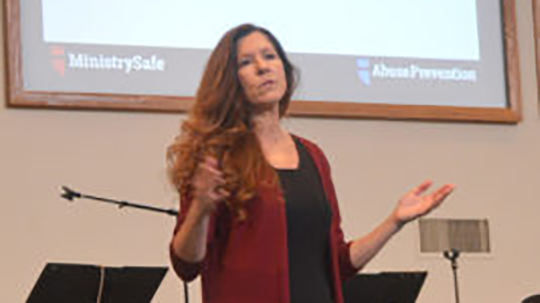After an article describing sexual abuse in Southern Baptist churches came out in the Houston Chronicle in February it wasn’t long before Kimberlee Norris’ phone started ringing.
She got dozens of calls from senior pastors, all asking how to deal with sexual abuse situations in their churches. The numbers, faces and tragedies depicted in the article hit home.
Norris, a Texas-based attorney who is an expert in legal standards of care related to child sexual abuse, has been providing crisis response to ministries and churches nationwide for years. She and Gregory Love, her husband and fellow attorney, started MinistrySafe to help churches be proactive by taking steps to prevent this type of crisis from ever happening.
Churches should be the safest place children can be — both to be safe from abuse inside its doors and to feel safe to report abuse outside its doors, Norris told those gathered March 26 for a workshop on sexual abuse sponsored by the Alabama Baptist State Board of Missions (SBOM) at Heritage Baptist Church, Montgomery.
“If we don’t address this issue we become the easy in for everyone who has the wrong motive,” Norris said. “Not only that — it can be mission killing. The only thing worse in public perception is if you murdered someone.”
When it comes to sexual abuse in the U.S. the numbers are high — 1 in 4 females and 1 in 6 males are sexually abused before they are 18 years old. Statistically there are enough convicted sex offenders in the U.S. for there to be more than one per every square mile — but even that’s a low estimate, Norris said, because less than 10 percent of offenders ever encounter the criminal justice system.
It makes sense that this issue would be something the church would face, she said — it skips no demographic. Not only that, the church and youth sports are “the most permeable entry points” for abusers seeking access to children, Norris said.
“We can’t stop it everywhere, but we can say, ‘Not with my kids, not on my watch, not in the name of Jesus in my ministry program,’” she said. “That’s the best we can do.”
Addressing our systems to keep children safe takes effort, but keeping children safe is worth any inconvenience, she said.
Safer ministry
MinistrySafe offers a five-step process to making your church’s children’s ministry safer (see story, page 13) as well as in-depth workshops on how to identify and protect your church.
For more information call Lee Wright at the SBOM at 334-613-2241, contact Norris at 817-737-7233 or visit ministrysafe.com.
———————————————————————————-
Preventing sexual abuse: A 5-part safety system
Here are five procedures churches should have in place:
1. Ensure your staff and volunteers attend sexual abuse awareness training.
This helps your employees and volunteers know the “why” behind the policies you adapt (see No. 4) and it gives them eyes to see and ears to hear grooming behaviors.
2. Use appropriate criminal background checks.
This isn’t a silver bullet and it isn’t all you need, but background checks are a necessary component of your children’s program or ministry. The depth of the check should match the degree of access to children, and these checks should be periodically refreshed, not just done once. Look for red-flag offenses, such as providing alcohol or porn to minors (this can be grooming behavior), exhibitionism or even simple assault. Sometimes child sexual assault cases are charged as simple assault instead. Perpetrators may have a story about how they got into a fight with a roommate when they were young and are ashamed of it. Don’t accept a person’s self-reported story of what happened as the absolute truth.
3. Apply skillful screening processes.
These are a critical component of an effective system. Train your staff to assess risks appropriately.
Communicate to applicants that your ministry screens heavily and monitors behavior. MinistrySafe offers long lists of helpful information for asking good interview questions and identifying risky responses or evasive answers. (For example, in response to the question, “Have you ever abused a child?” instead of answering with a simple, “No,” the interviewee says, “I would never abuse a child.”)
You can also look for red flags in an application like gaps in time between listed employment.
4. Put tailored policies and procedures in place.
Policies are what you do not what you say you do. Don’t make exceptions for anyone. There’s no one-size-fits-all for what your procedures should be — they should be tailored to fit your church’s ministry. But they should include some basics like the two-adult rule (no adult left alone with a child), bathroom policies (such as having an adult stand in an open doorway and provide accountability when children are going to the bathroom) and the six-month member rule (a minimum time period someone must be a church member before volunteering in the children’s ministry).
5. Enforce monitoring and oversight of volunteers and employees.
Do what you say you’ll do when it comes to keeping an eye on your people. Perform periodic reviews and provide accountability. (Adapted from MinistrySafe information)
——————————————————————————————————–
It’s not just adults — peer-to-peer abuse is real too
It might be hard to imagine a child abusing another child, but it does happen — especially if the one acting out the abuse has been abused in the past too. It can happen when there is an imbalance of power (one child is older, larger or has more social status).
With the exception of high school ministry Kimberlee Norris of MinistrySafe recommends not having children together in a ministry setting that has an age range of more than three years.
She also recommends putting rules in place like the “one kid, one stall” rule in the bathroom, having adults patrol bathrooms and not sending young children to the bathroom alone.
Understanding the grooming process
1. Gaining access.
Potential abusers groom both the child and the gatekeeper (other adults they work or serve with) to gain trust.
“They need trusted time alone with that child, and you’re not going to give time alone with your child to anyone you don’t deem trustworthy,” said Kimberlee Norris of MinistrySafe.
Gifts and activities
Often abusers come across as charismatic, trustworthy people. They’re also skilled at figuring out what a child needs or wants and communicating with them. This could mean giving gifts or having “kid magnet” activities at their home, like video games for young boys.
2. Selecting a child.
They often look for a child who is unconnected, on the fringe or in need — possibly a child who is looking for someone to trust, like a child without a father figure. A child who is very physically affectionate is also more at risk than a child who isn’t because they already accept more physical touch.
3. Introducing nudity and sexual touch.
Abusers will test barriers and slowly erode them. This can be through playful touch like wrestling or tickling, telling dirty jokes or creating a culture where nudity is acceptable or cool (like skinny dipping).
4. Keeping the victim silent.
Abusers will use secrecy, threats and shame to keep victims quiet. This could be anything from “if you tell, you’ll get in trouble” to “this could wreck our youth group.” (Adapted from MinistrySafe information)






Share with others: